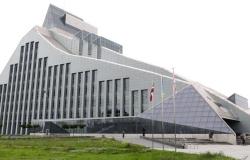
“Finally putting an end to the long-term dependence on transit of Russian origin – this is in the interests of Latvia’s security and growth,” notes Briškens.
He points out that at the meeting, the MoU proposed five priority directions for reorienting Latvia’s port and logistics industry, including cargo flows and investments from allied countries, Latvian exports and domestic transportation, industrial development in ports/special economic zones, renewable energy projects and military mobility .
New cargo directions must be sought
The first direction is freight flows and investments originating from allied countries. Briškens points out that new cargoes will not appear by themselves, so Latvia must actively search for them.
“In the last 12 years, I am the first Minister of Transport to address the US Secretary of Transportation about US investments in Latvian ports. In recent years, the US has been channeling significant investments and supplies of industrial cargo to Central Asia, as well as the Caspian Sea and Caucasus regions. For example, “General” is already being used in the port of Riga Motors” for the delivery of automotive cargo in Uzbekistan. This is an opportunity for Latvia. We must actively lobby for our role in ensuring the interests of the United States – the benefit will be not only economic, but also in terms of our safety,” the minister says.
In the near future, the minister is planning visits to Germany, Denmark and Belgium to look for new opportunities for cooperation. He notes that the same is true of sea cargo from the Far East to Central Europe, adding that Latvian ports are currently not using their full potential to compete with the large European ports.
“For example, comparing the entire supply chain Hamburg-Prague and Riga-Prague, we have an advantage of 300-400 euros per transported container. This is a very significant advantage that our southern neighbors have been using for a long time,” says Brišken.
He notes that if Latvia’s economy currently earns approximately 17 euros per ton from low-added-value transit, then joining such higher-added-value supply chains would at least double Latvia’s benefit. “Latvia has to strategically look at the markets of North America, Western and Nordic countries, as well as Central Asia,” emphasizes Briškens.
Ro-ro cargo transportation is also a priority, including strengthening strategic cooperation with “Stena Line” and channeling investments into the reconstruction of piers in order to accommodate larger ships.
Export and domestic transportation
As another direction, the minister points out Latvia’s export and domestic transportation. Commenting on what should be done with VAS “Latvijas dzelzceļš” (LDz), with the significant drop in Russian cheap cargo volumes, he points out that it is logical to start with domestic cargo transportation, promoting the transfer of cargo from road transport to rail.
Briškens says that Latvia has long invested huge amounts of European Union (EU) funds in the expansion of cheap transit infrastructure, but the need to connect industrial parks with the railway, as well as to build domestic terminals, was forgotten.
“These mistakes must be corrected urgently. For example, we have started cooperation with grain-growing cooperatives on the integration of grain elevators into the railway system, and we will also start negotiations with the Ministry of Agriculture about AS “Latvijas valsts meži” using the railway for its wood export. In addition, the MoU will forward to the Minister the cabinet’s proposal on the redistribution of EU funds for the creation of several domestic intermodal terminals, or dry ports,” adds Briškens.
He notes that the MoU will support port area development projects to promote exports. Specifically, the Liepāja Special Economic Zone (SEZ) and Ventspils Freeport projects on the creation of drinking water terminals for export to the Middle East and other regions of the world.
Development in ports and SEZs
Thirdly, the MoU emphasizes industrial development in ports/special economic zones (SEZs). “The operation of ports should not be judged only by the amount of tons handled. Already, the industrial development of the port territories is already of greater benefit to the Latvian economy,” notes Briškens.
He informs that there are already more than 50 factories in the industrial parks of the ports of Liepāja and Ventspils. Thus, supporting the further development of these industrial parks and the Riga Freeport Spilve industrial park could attract foreign investments and the presence of new export-capable companies in Latvia.
“A concrete example – I recently visited the “Bucher” production facility based in the Ventspils port industrial park. This Swiss company exports street cleaning machines produced in Latvia to more than 30 countries, its turnover is over 80 million euros, and it provides approximately 400 well-paid jobs in Latvia. This is just one of several examples and opportunities that the country needs to increase with support,” Brišken adds.
Renewable resources projects
The fourth direction is energy projects of renewable resources. The minister emphasizes that one of Latvia’s strategic priorities is the promotion of energy independence.
As Briškens notes, the company “Van Oord Dredging and Marine Contractors BV” has already signed an agreement with Liepāja port for the construction of a support base for offshore wind farms and a large cargo terminal. Similarly, the port of Ventspils is involved in the “Elwind” project. “Specifically, we are talking about opportunities for a manufacturing base for wind turbine structures, wind turbine assembly and assembly.”
Briškens also emphasizes that Latvia can also take a strong position in the conversion of produced energy into hydrogen, green ammonia and other renewable energy products in production and storage.
The MoU supports the plans of Liepāja and Ventspils for the construction of hydrogen factories, and the ministry is also ready to participate in the development of the future hydrogen economy.
“The state must provide the necessary support for the provision of infrastructure and the attraction of foreign investors. These investments will pay off for the state in well-paid jobs, higher tax revenues and the achievement of climate goals,” says the minister.
Military mobility
On the other hand, the fifth direction proposed by the MoU is military mobility. Briškens notes that it is critical for Latvia to promote connectivity with allies in the West for quick delivery of military cargo in the Baltics, adding that railway and port infrastructure is an integral part of Latvia’s security architecture.
“Therefore, work is already underway to increase the capacity of Latvian ports to receive such cargoes. This requires the development of port terminals, so that we can create as many places as possible where any type of equipment – from semi-trailers to tanks – can be promptly unloaded and moved,” notes Brisken.
He also notes that the rail network needs to be adjusted for the mobility of these loads. Thus, the Ministry of Defense actively cooperates with the Ministry of Defense to adapt both the existing railway and port infrastructure, as well as specific solutions incorporated into the infrastructure of the future railway project “Rail Baltica” for the needs of military mobility, creating cargo unloading ramps on both banks of the Daugava, several transshipment points and terminals, connection with port and other solutions.
Also cooperation with Central Asian countries
Minister of Economy Viktors Valainis (Union of Greens and Farmers) stated that both completed and initiated works were evaluated in order to strengthen the advantages of Latvian ports and reorient the operational structure of our ports. One of the directions would be the reorientation of internal cargo to the railway, which would also mean developing the business parks of Valmiera, Jēkabpils, Jelgava and Daugavpils, connecting them with the port infrastructure.
Today’s meeting also discussed closer cooperation and focusing on cargo transportation of Central Asian countries, closer control of sanctions compliance mechanisms, as well as cooperation with Western Europe in energy projects, the Minister of Economy said.
Valainis added that if, for example, more thoughtful decisions had been made in the port of Riga, the situation would be different. Instead of developing business infrastructure and construction of production buildings, a wall of coal dust was built in the port of Riga to ensure cargo tonnage, not quality.
Valainis believes that the above can be done if there is a strategy to achieve it. So far there have been only talks and no clear vision.
CONTEXT:
After the beginning of Russia’s repeated invasion of Ukraine, the supplies of manganese ore needed for the weapons industry to Russia increased dramatically. As the newspaper “Postimees” reported, since last year some deliveries have been made through the port of Sillame, whose operating company is half owned by the former Prime Minister of Estonia Tītas Vehi, as well as through Latvia.
Preliminary data show that in 2023, Russia imported two million tons of manganese ore, which is a record amount. Manganese ore is used in the production of high-quality steel required for gun barrels, armored vehicles and tracks for such vehicles.
According to the information available to “Postimees”, almost 90% of the two million tons of manganese ore exported to Russia last year was transshipped in Estonia and Latvia. Most of such cargoes are transshipped in the ports of Riga and Ventspils, but since last year, manganese ore has also been unloaded and stored in Sillame port before the trains go to Russia with it.
The Latvian state railway company “LDz Logistika” is one of several Latvian companies that participated in the transportation of manganese ore to Russia.
International sanctions do not prohibit the transportation of manganese ore to Russia. The government of Latvia calls for this issue to be resolved at the level of the European Union (EU) – to include manganese ore in the next EU sanctions against Russia.
Tags: Ministry offers directions reorientation Latvian ports logistics industry Russia Article
-




